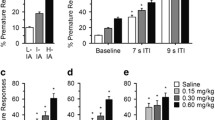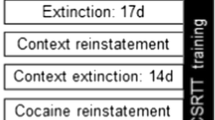Abstract
Introduction
Understanding an individual’s vulnerability to drug addiction has important implications for the development of effective personal treatment plans. Although theories acknowledge impulsive behaviour as a key component of drug addiction, little is known about the influence of trait impulsivity on an individual’s susceptibility to the effects of psychostimulants on impulsivity at critical phases of the addiction cycle.
Methods
This study investigated the short and longer-term effects of chronic nicotine administration on impulsive choice in rats selected for high (HI) and low impulsivity (LI) on a delay discounting task. Rats prepared with subcutaneously osmotic mini-pumps received either nicotine (3.16 mg/kg/day [freebase]) or saline for 7 days. Performance was assessed during chronic treatment, early and late withdrawal, and in response to acute nicotine challenges following prolonged abstinence.
Results
Chronic nicotine increased impulsive choice in LI but not HI animals. Spontaneous withdrawal was associated with a nicotine abstinence syndrome, the early stages of which were characterised by opposing effects on impulsive choice in HI and LI animals. A transient decrease in impulsivity was observed in HI animals whilst the LI group remained more impulsive for up to 1 week following drug termination. Following normalisation of behaviour, acute nicotine challenges (0.125, 0.25, 0.5 mg/kg, SC) markedly increased impulsive choice regardless of trait impulsivity and drug history.
Conclusion
The results indicate that only LI individuals are vulnerable to chronic drug- and withdrawal-induced impairments in self-control which may increase the likelihood of the transition to, and maintenance of, nicotine dependence.





Similar content being viewed by others
References
Anderson KG, Diller JW (2010) Effects of acute and repeated nicotine administration on delay discounting in Lewis and Fischer 344 rats. Behav Pharmacol 21:754–764
Anker JJ, Zlebnik NE, Gliddon LA et al (2009) Performance under a Go/No-go task in rats selected for high and low impulsivity with a delay-discounting procedure. Behav Pharmacol 20:406–414
Aron AR, Robbins TW, Poldrack RA (2004) Inhibition and the right inferior frontal cortex. Trends Cogn Sci 80:170–177
Ashare RL, Hawk LW Jr (2012) Effects of smoking abstinence on impulsive behaviour among smokers high and low in ADHD-like symptoms. Psychopharmacology 219:537–547
Aytaclar S, Tarter RE, Kirisci L, Lu S (1999) Association between hyperactivity and executive functioning in childhood and substance use in adolescence. J Am Acad Child Adolesc Psychiatry 38:172–178
Belin D, Mar AC, Dalley JW et al (2008) High impulsivity predicts the switch to compulsive cocaine-taking. Science 320:1352–1355
Benowitz NL (1988) Pharmacological aspects of cigarette smoking and nicotine addiction. New Engl J Med 319:1318–1330
Bickel WK, Odum AL, Madden GJ (1999) Impulsivity and cigarette smoking: delay discounting in current, never, and ex-smokers. Psychopharmacology 146:447–454
Bobko P (1986) A solution to some dilemmas when testing hypotheses about ordinal interactions. J Appl Psychol 71:323–326
Broos N, Diergaarde L, Schoffelmeer ANM et al (2012) Trait impulsive choice predicts resistance to extinction and propensity to relapse to cocaine seeking: a bidirectional investigation. Neuropsychopharmacology 37:1377–1386
Cardinal RN, Robbins TW, Everitt BJ (2000) The effects of d-amphetamine, chlordiazepoxide, alpha-flupenthixol and behavioural manipulations on choice of signalled and unsignalled delayed reinforcement in rats. Psychopharmacology 152:362–375
Cardinal RN, Pennicott DR, Sugathapala CL, Robbins TW, Everitt BJ (2001) Impulsive choice induced in rats by lesions of the nucleus accumbens core. Science 292:2499–2501
Christakou A, Robbins TW, Everitt BJ (2004) Prefrontal–ventral striatal system involved in affective modulation of attentional performance: implications for cortico-striatal circuitry function. J Neurosci 24:773–780
Dallery J, Locey ML (2005) Effects of acute and chronic nicotine on impulsive choice rats. Behav Pharmacol 16:15–23
Dalley JW, Lääne K, Pena Y et al (2005) Attentional and motivational deficits in rats withdrawn from intravenous self-administration of cocaine of heroin. Psychopharmacology 182:579–587
Dalley JW, Fryer TD, Brichard L et al (2007a) Nucleus accumbens D2/3 receptors predict trait impulsivity and cocaine reinforcement. Science 315:1267–1270
Dalley JW, Laane K, Theobald DE et al (2007b) Enduring deficits in sustained visual attention during withdrawal of intravenous methylenedioxymethamphetamine self-administration in rats: results from a comparative study with d-amphetamine and methamphetamine. Neuropsychopharmology 32:1195–1206
De Wit H (2008) Impulsivity as a determinant and consequence of drug use: a review of underlying processes. Addict Biol 14:22–31
De Wit H, Crean JP, Richards JB (2000) Effects of d-amphetamine and ethanol on a measure of behavioral inhibition in humans. Behav Neurosci 114:830–837
Diergaarde L, Pattij T, Poortvliet I et al (2008) Impulsive choice and impulsive action predict vulnerability to distinct stages of nicotine seeking in rats. Biol Psychiatry 63:301–308
Doran N, Cook J, McChargue D et al (2009) Impulsivity and cigarette craving: differences across subtypes. Psychopharmacology 207:365–373
Eagle DM, Tufft MRA, Goodchild HL, Robbins TW (2007) Differential effects of modafinil and methylphenidate on stop-signal reaction time task performance in the rat, and interactions with the dopamine receptor antagonist cis-flupenthixol. Psychopharmacology 192:193–206
Economidou D, Pelloux Y, Robbins TW et al (2009) High impulsivity predicts relapse to cocaine-seeking after punishment-induced abstinence. Biol Psychiatry 65:851–856
Ersche KD, Jones PS, Williams GB et al (2012) Abnormal brain structures implicated in stimulant drug addiction. Science 335:601–604
Evenden JL (1999) Varieties of impulsivity. Psychopharmacology 146:348–361
Evenden JL, Ryan CN (1996) The pharmacology of impulsive behaviour in rats: the effects of drugs on response choice with varying delays of reinforcement. Psychopharmacology 128:161–170
Field M, Santarcangelo M, Sumnall H et al (2006) Delay discounting and the behavioural economics of cigarette purchases in smokers: the effects of nicotine deprivation. Psychopharmacology 186:255–263
Fung YK, Schmid MJ, Anderson TM, Lau YS (1996) Effects of nicotine withdrawal on central dopaminergic systems. Pharmacol Biochem Behav 53:635–640
Grunberg NE, Bowen DJ, Winders SE (1986) Effects of nicotine on weight and food consumption in female rats. Psychopharmacology 90:101–105
Harrison ELR, Coppola S, McKee SA (2009) Nicotine deprivation and trait impulsivity affects smokers performance on cognitive tasks of inhibition and attention. Exp Clin Psychopharmacol 17:91–98
Howell DC (2010) Statistical methods for psychology, 7th edn. Wadsworth Publishing, Canada
Huskinson SL, Krebs CA, Anderson KG (2012) Strain differences in delay discounting between Lewis and Fischer 344 rats at baseline and following acute and chronic administration of d-amphetamine. Pharmacol Biochem Behav 101:403–416
Jentsch JD, Taylor JR (1999) Impulsivity resulting from frontostriatal dysfunction in drug abuse: implications for the control of behaviour by reward-related stimuli. Psychopharmacology 146:373–390
Kelsey JE, Niraula A (2013) Acute and sub-chronic nicotine on impulsive choice in rats in a probabilistic delay-discounting task. Psychopharmacology 227:385–392
Kirby NM, Petry NM (2004) Heroin and cocaine abusers have higher discount rates for delayed rewards than alcoholics or non-drug-using controls. Addiction 99:461–471
Kolokotroni KZ, Rodgers JR, Harrison AA (2011) Acute nicotine increases both impulsive choice and behavioural disinhibition in rats. Psychopharmacology 217:455–473
Kolokotroni KZ, Rodgers JR, Harrison AA (2012) Effects of chronic nicotine, nicotine withdrawal and subsequent nicotine challenges on behavioral inhibition in rats. Psychopharmacology 219:453–468
Krishnan-Sarin S, Reynolds B, Duhig AM et al (2007) Behavioral impulsivity predicts treatment outcome in a smoking cessation program for adolescent smokers. Drug Alcohol Depend 88:79–82
Liu SJ, Heitz RP, Bradberry CW (2009) A touch screen based stop signal response task in rhesus monkeys for studying impulsivity associated with chronic cocaine self-administration. J Neurosci Methods 177:67–72
Madden GJ, Petry N, Badger G, Bickel WK (1997) Impulsive and self-control choices in opioid dependent subjects and non-drug using controls: drug and monetary rewards. J Exp Clin Psychopharmacol 5:256–262
Malin DH, Lake JR, Newlin-Maultsby P et al (1992) Rodent model of nicotine abstinence syndrome. Pharmacol Biochem Behav 43:779–784
McMorrow MJ, Foxx RM (1983) Nicotine role in smoking – an analysis of nicotine regulation. Psychol Bull 93:302–327
Mitchell SH (2004) Effects of short-term nicotine deprivation on decision-making: delay, uncertainty and effort discounting. Nicotine Tob Res 6:819–828
Miyata G, Meguid MM, Fetissov SO et al (1999) Nicotine’s effect on hypothalamic neurotransmittors and appetite regulation. Surgery 126:255–263
Monterosso J, Aron AR, Cordova X et al (2005) Deficits in response inhibition associated with chronic methamphetamine abuse. Drug Alcohol Depend 79:273–277
Nisell M, Nomikos GG, Hertel P, Panagis G, Svensson TH (1996) Condition-independent sensitization of locomotor stimulation and mesocortical dopamine release following chronic nicotine treatment in the rat. Synapse 22:369–381
Paine TA, Dringenberg HC, Olmstead MC (2003) Effects of chronic cocaine on impulsivity: relation to cortical serotonin mechanisms. Behav Brain Res 147:135–147
Perry JL, Stairs DJ, Bardo MT (2008) Impulsive choice and environmental enrichment: effects of d-amphetamine and methylphenidate. Behav Brain Res 193:48–54
Potter AS, Newhouse PA (2004) Effects of acute nicotine administration on behavioral inhibition in adolescents with attention-deficit/hyperactivity disorder. Psychopharmacology 176:182–194
Potter AS, Bucci DJ, Newhouse PA (2012) Manipulation of nicotinic acetylcholine receptors differentially affects behavioural inhibition in human subjects with and without disordered baseline impulsivity. Psychopharmacology 220:331–340
Poulos CX, Parker JL (1995) Impulsivity predicts individual susceptibility to high levels of alcohol self-administration. Behav Pharmacol 6:810–814
Richards JB, Mitchell SH, de Wit H, Seiden LS (1997) Determination of discount functions in rats with an adjusting-amount procedure. J Exp Anal Behav 67:353–366
Richards JB, Sabol KE, de Wit H (1999) Effects of methamphetamine on the adjusting amount procedure, a model of impulsive behaviour in rats. Psychopharmacology 146:432–439
Robinson TE, Berridge KC (1993) The neural basis of drug craving: an incentive-sensitisation theory of addiction. Brain Res Rev 18:247–291
Robinson TE, Berridge KC (2003) Addiction. Ann Rev Psychol 54:25–53
Simon MW, Mendez IA, Setlow B (2007) Cocaine exposure causes long term increases in impulsive choice. Behav Neurosci 121:543–549
Stanis JJ, Avila HM, White MD, Gulley JM (2008) Dissociation between long-lasting behavioral sensitization to amphetamine and impulsive choice in rats performing a delay-discounting task. Psychopharmacology 199:539–548
Tabachnick BG, Fidell LS (2007) Using multivariate statistics, 3rd edn. Pearson Education Inc., New York
Tarter RE, Kirisci L, Feske U, Vanyukov M (2007) Modeling the pathways linking childhood hyperactivity and substance use disorder in young adulthood. Psychol Addict Behav 21:266–277
Van Gaalen MM, Brueggeman RJ, Bronius PFC et al (2006) Behavioral disinhibition requires dopamine receptor activation. Psychopharmacology 187:73–85
Vuchinich RE, Simpson CA (1998) Hyperbolic temporal discounting in social drinkers and problem drinkers. Exp Clin Psychopharmacol 6:292–305
Winstanley CA, Dalley JW, Theobold DEH, Robbins TW (2003) Global 5-HT depletion attenuates the ability of amphetamine to decrease impulsive choice on a delay discounting task in rats. Psychopharmacology 170:320–321
Winstanley CA, Eagle DM, Robbins TW (2006) Behavioural models of impulsivity in relation to ADHD: translation between clinical and preclinical studies. Clin Psychol Rev 26:379–395
Winstanley CA, Bachtell RK, Theobold DEH et al (2009) Increased impulsivity during withdrawal from cocaine self-administration: role of FosB in the orbitofrontal cortex. Cereb Cortex 19:435–444
Yakir A, Rigbi A, Kanyas K et al (2007) Why do young women smoke? III. Attention and impulsivity as neurocognitive predisposing factors. Eur Neuropsychopharmacol 17:339–351
Zhang L, Meguid MM, Miyata G et al (2001) Role of hypothalamic monoamines in nicotine-induced anorexia in menopausal rats. Surgery 130:133–142
Acknowledgements
The authors gratefully acknowledge the support of the Institute of Psychological Sciences (IPS), University of Leeds and Leeds Metropolitan University, UK.
Author information
Authors and Affiliations
Corresponding author
Electronic supplementary material
Below is the link to the electronic supplementary material.
ESM 1
(DOC 1442 kb)
Rights and permissions
About this article
Cite this article
Kolokotroni, K.Z., Rodgers, R.J. & Harrison, A.A. Trait differences in response to chronic nicotine and nicotine withdrawal in rats. Psychopharmacology 231, 567–580 (2014). https://doi.org/10.1007/s00213-013-3270-y
Received:
Accepted:
Published:
Issue Date:
DOI: https://doi.org/10.1007/s00213-013-3270-y




